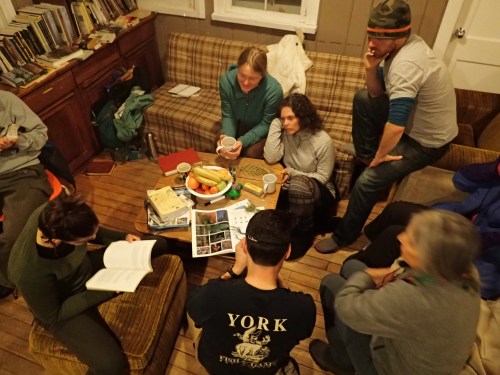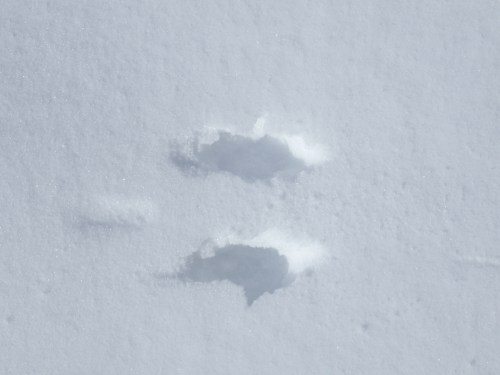A few days ago I got to go out tracking with some friends. We came across some great stuff I’d like to share with you including ritual bear trails and moose sign.

One of the first things we came across were little tubes made of pine needles like the ones above. They hold a moth larva that overwinters inside. I had never noticed them before.

Kersey had been here before and brought us to this ritual Black Bear trail. The bears walk in the footsteps of past bears, grinding their feet into the ground, leaving sometimes obvious and long lasting impressions. It is hard to see in the photo though they were quite clear in person.
This sign is usually associated with marking trees though we didn’t find any. We were more focused on something else.

Lee is from South Africa where he runs Nature Guide Training which teaches guides and other students about African wildlife. He was intensely curious about everything.

Kersey runs Original Wisdom which also trains people in wildlife tracking and other Naturalists studies. She is generously mentoring Deneen and I in trailing wildlife (the act of following tracks to the animal who made them). More on that later.
Mike is a tracker and forager who is on his way to great renown in the world of survival skills. He was also known on this day as Samwise sans frying pan.

We also found some of the largest Red Squirrel middens I have ever seen. Red Squirrels store food in large amounts, usually underground, in what are called larders. They eat this food while perched in a favorite spot leaving a big pile of scraps, in this case pine cone parts.




In another area of the woods where more bear sign in the form of torn apart rotten logs. Bears dig through them looking for grubs to eat. I especially like the one below as the bears hind feet pushed down the ferns below the logs giving a better impression of it movements. The destruction seems intense however I bet it is quite a deliberate act on the part of the bear, possibly even slow and methodical.


A bear had been up this big old maple tree leaving some claw marks. They may eat the maple seeds up there though that is just my guess.

Another cool find was the fruiting body of a type of foxfire fungus. There are several types of fungus that are referred to as foxfire because they are phosphorescent (glow in the dark). I have yet to determine the species here. It is the one responsible for the greenish blue rotten wood one often sees in New England.
The main purpose of this trip was to practice trailing. Deneen was not able to be with us this day so it was me and Mike under the tutelage of the experts. We had found some old moose sign early in our time.

Eventually we found a trail to follow. Below is a track, one of the very few obvious to me.


The tracks were very difficult for me to find. Some were clear, two or three or four in a row, then nothing. The terrain was not what would be called easy.

After loosing the trail and finding it again (usually it was re-found by one of the others) we would come across something really obvious. When Lee called us over to this moose scat he said, in that dry humor of experienced outdoors people, “I think it may have been here.”


I wasn’t going to find a moose that day, the trail was a little old and really difficult to follow. That was fine with me because I was following a trail further than ever before. Sure in snow I have followed trails for miles, even catching up to the animal. That’s easy. This was challenging. I searched for occasional clear sign like the image above of crushed logs and sticks, loosing the trail again and doubling back to the certain print to start over.
I had one really good sequence that I had found by myself and followed a few dozen yards with confidence. In that moment it was pretty clear that I was made for this stuff.
It was also quite humbling as I stumbled around, to be with two people who routinely track lions in Africa this way.
Imagine that… lions.



































